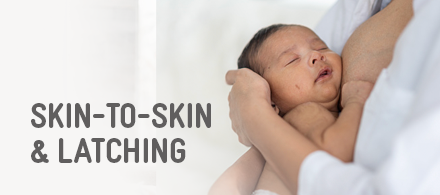
Skin-to-skin contact encourages both breastfeeding/chestfeeding and bonding in baby’s first days
- Relax in a comfortable position and lay baby on your bare chest in the first hour for skin-to-skin contact.
- Cover baby with blanket to keep warm.
- Make eye contact, talk, sing and enjoy your time together.
- It can be discouraging if your baby doesn’t latch immediately. Give them time, they are learning too.
- Continue skin-to-skin contact during your hospital stay and when you get back home. The more time you spend in skin-to-skin contact, the easier it will be for your baby to find the nipple and latch-on. Babies learn to breastfeed/chestfeed by being at the breast or chest.
